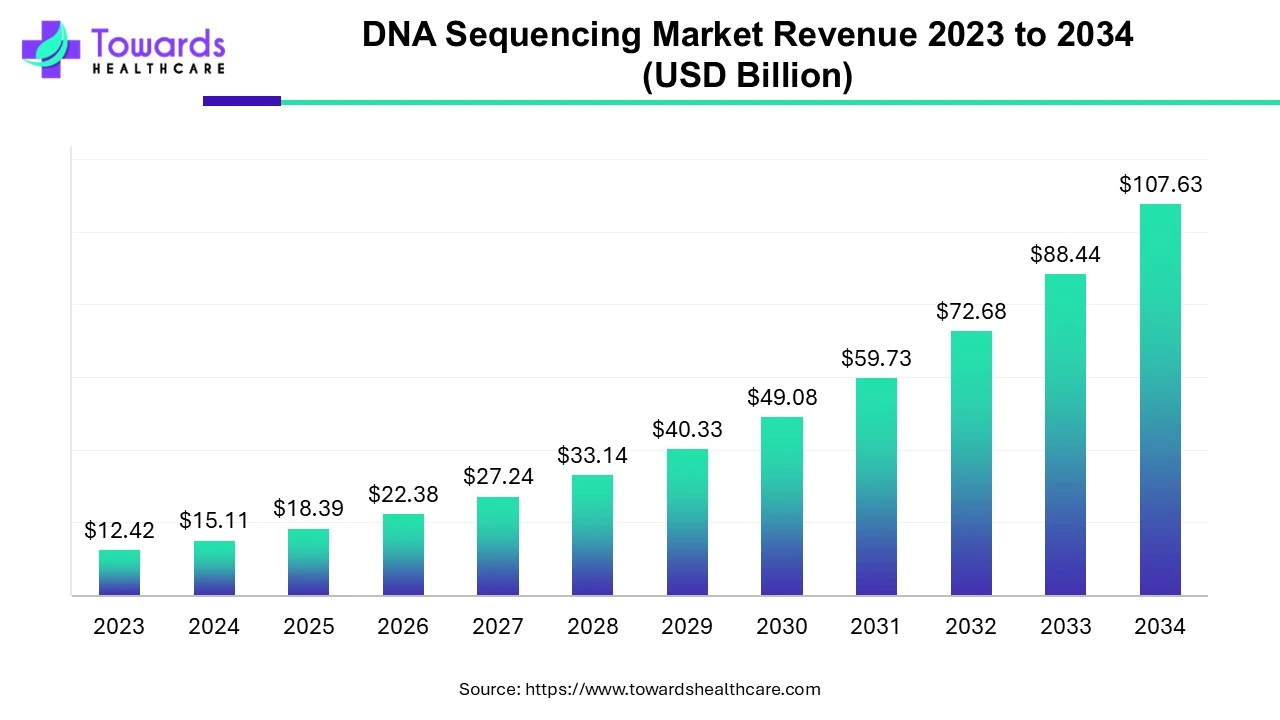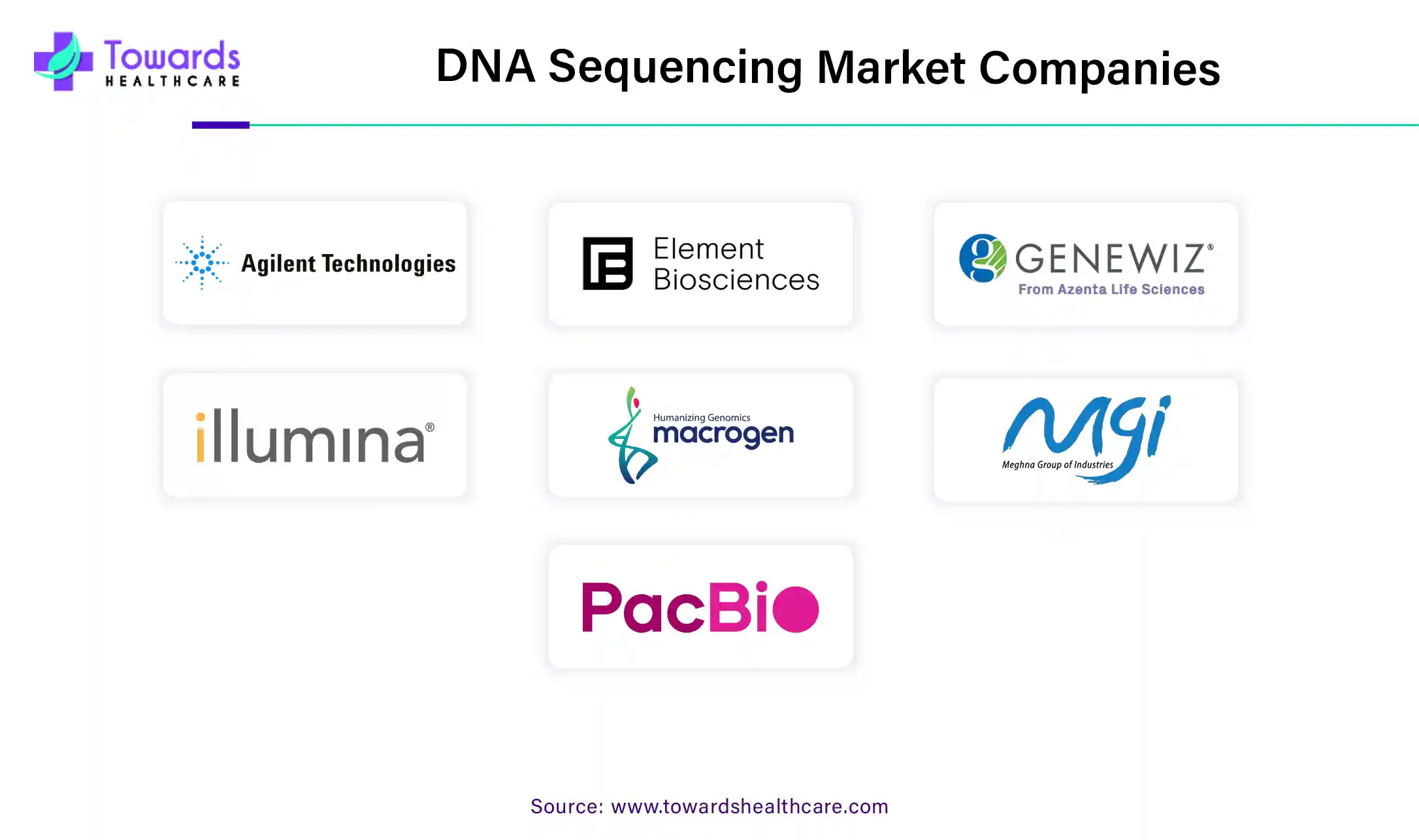November 2025


DNA sequencing is a technique for determining the nucleic acid sequence, i.e., the order of nucleotides in a DNA molecule. These sequences give an idea about biological information and aid in understanding the function of genes and the other parts of the genome. Knowledge of DNA sequences is helpful in numerous fields, such as biological research, medical diagnosis, biotechnology, forensic biology, virology, and biological systematics. The DNA sequencing technique can also be used to indirectly sequence RNA or proteins. In addition, DNA sequencing is used in forensic science for forensic identification and paternity testing. Furthermore, it is also used in conservation biology to study the genetic characteristics of endangered species and develop strategies for their conservation.
The rising prevalence of genetic and rare disorders and cancer necessitates the study of DNA sequences, promoting the market. The COVID-19 pandemic highlighted the significance of rapid genomic insights. The growing research and development and favorable government policies supporting the human genome project drive the market. Additionally, the rising demand for personalized medicines boosts the market.
| Metric | Details |
| Market Size in 2024 | USD 15.11 Billion |
| Projected Market Size in 2034 | USD 107.63 Billion |
| CAGR (2025 - 2034) | 21.69 |
| Leading Region | North America |
| Market Segmentation | By Product, By Technology, By Workflow, By Application, By End-Use and By Region |
| Top Key Players | Agilent Technologies, Element Biosciences, Genewiz, Illumina, Inc., Macrogen, MGI, OncoDNA, Oxford Nanopore, PacBio, Perkin Elmer, Qiagen, Roche Diagnostics, Thermo Fisher Scientific, Wasatch BioLabs |
The anomalies of the conventional DNA sequencing methods can be overcome by developing novel and advanced DNA sequencing techniques. The advent of technology and automation drives the latest innovations in techniques, thereby increasing speed and lowering the cost of sequencing. Some recent developments in DNA sequencing methods include next-generation sequencing (NGS), long-read & short-read sequencing, DNA polymerase-based sequencing, nanopore-based sequencing, and high-fidelity technology. The primary aim of developing novel methods is to increase accuracy and scalability. Additionally, incorporating artificial intelligence and machine learning algorithms streamlines the entire genomics research process. AI and ML can operate, extract, and interpret the valuable genetic information hidden within large datasets. Efforts are also made to predict future variations in the genomes of viruses to assist public health efforts.
The major challenge of the market is the privacy concern regarding genetic data. There are chances of misuse and discrimination of genetic data, hampering the privacy and security of an individual. This further restricts the involvement of individuals. Another major challenge is the high upfront cost of the sequencing laboratory. The infrastructure and equipment required to set up and maintain a sequencing lab demand huge capital investment, limiting the affordability of several organizations in LMICs.
By product, the consumables segment held a dominant presence in the DNA sequencing market in 2023. Consumables consist of various reagents, buffers, purification solutions, etc., needed for DNA sequencing. The increasing demand for genomics, affordability of consumables, and the latest innovations in sequencing methods potentiate the segment’s growth.
By product, the services segment is expected to grow at the fastest rate in the market during the forecast period. Sequencing services are preferred as they save a lot of time for researchers and provide accurate results as experiments are performed by technical experts.
By technology, the next-generation sequencing segment accounted for the largest share of the DNA sequencing market in 2023. Next-generation sequencing (NGS) is a type of DNA sequencing technique used for sequencing DNA/RNA and detecting variants/mutations. The segment’s growth is attributed to its ultra-high-throughput, scalability, speed, and widespread applications.
By technology, the third-generation sequencing segment is anticipated to grow with the highest CAGR in the market during the studied years. Third-generation sequencing has superior advantages over NGS due to enhanced diagnostic accuracy and increased speed and efficiency.
By workflow, the sequencing segment led the DNA sequencing market in 2023. This segment dominated because it is the most essential step involved in DNA sequencing. Sequencing is one of the major steps involved in DNA sequencing, wherein the nucleotides are read on a sequencer at a read length.
By workflow, the data analysis segment is projected to expand rapidly in the market in the coming years. Data analysis is one of the crucial steps in DNA sequencing for interpreting the outcomes. Bioinformatics tools interpret the data generated. The segment’s growth is attributed to novel innovations in software with evolving graphic user interfaces.
By application, the oncology segment registered its dominance over the DNA sequencing market in 2023. The segmental growth is attributed to the rising incidence of cancer, leading to increased demand for its early detection. The segment also dominated due to favorable government policies to improve diagnosis and care for cancer. DNA sequencing can predict the occurrence of cancer in infants through genetic data.
By application, the consumer genomics segment is estimated to grow fastest in the market during the forecast period. The increasing awareness about the prevention of disease in neonates, the latest innovations, and widespread applications drive the segment’s growth.
By end-use, the academic research segment dominated the DNA sequencing market in 2023. The increasing funding for academic research by government and private organizations promotes the segment’s growth. The market is also driven by frequent symposiums and conferences for academic researchers.
By end-use, the clinical research segment is anticipated to expand rapidly in the market during the forecast period. The presence of technical expertise, favorable infrastructure, and sufficient funding augments the segment’s growth.
North America held the largest share of the DNA sequencing market in 2023. The presence of key players, rising incidences of rare disorders and cancer, technological advancements, and state-of-the-art research and development facilities drive the market. The US government actively supports DNA sequencing research and development to improve public health. The National Human Genome Research Institute provides funding to research institutions and organizations implementing DNA sequencing. In August 2024, the US FDA announced using whole genome sequencing to protect consumers from foodborne illness globally. Similarly, the Canadian government announced an investment of $15 million over five years to establish a national genomic data management system, the Pan-Canadian Genome Library (PCGL).
Asia-Pacific is projected to host the fastest-growing DNA sequencing market in the coming years. The rising geriatric population, rapidly changing demographics, increasing investments & collaborations, and favorable government policies drive the market. The Five-Year Plan (2021-2025) by the Chinese government to strengthen the biotech sector in the region accounted for more than 10% of R&D investment. In March 2024, the Genome India Project, a project funded and coordinated by the Department of Biotechnology, announced that it had finished sequencing 10,000 Indian genomes. This potentiates bio-economy growth in India by 13-fold in the last decade. India is currently among the top 12 bio-manufacturers in the world.
China is a major player in the global DNA sequencing market, particularly in the Asia-Pacific region. This is because the strong government support actively promotes the development of the biotechnology industry, including DNA sequencing, through initiatives like the Precision Medicine Initiative and investments in genomics research. Advancements of China in NGS technologies led to the development of innovative sequencing platforms and services. DNA sequencing is increasingly used in China for clinical diagnostics, personalized medicine, and research in areas like cancer treatment, which further drives the market expansion.
India is experiencing rapid growth in the DNA sequencing market. Due to its increasing research capabilities in genomics and biotechnology, along with a large population and diverse genetic makeup, it makes it an attractive market for genomics research and personalized medicine. The Indian government is also investing in genomics research and infrastructure, reinforcing the growth of the DNA sequencing market by increasingly being adopted for diagnostic purposes, including cancer screening and genetic testing.
Europe is considered to be a significantly growing area in the DNA sequencing market, due to the growing genomics research and favorable government policies to encourage early diagnosis and treatment of genetic and rare disorders. Numerous government and private organizations provide funding for research activities. The presence of a robust healthcare infrastructure and the burgeoning genomics sector boost the market. The presence of key players, such as Macrogen Europe, Eurofins Genomics, and SEQme, majorly contributes to market growth in Europe.
It is estimated that more than 4 million people are living with rare disorders in Germany. This encourages researchers to develop diagnostics based on DNA sequencing or study disease progression using genomics. The German government also makes certain efforts to provide advanced care. The government has also established the Centers for Rare Diseases as part of the National Action Plan.
Currently, 3.5 million people in the UK are living with a rare disorder, accounting for 1 in 17 people. (Source: Genetic Alliance) The UK government launched the 2025 England Rare Diseases Action Plan to improve the diagnosis, treatment, and research for rare diseases. The three main objectives are establishing new models for multi-system disorder clinics, enhancing the UK’s position as a leader in rare disease clinical research, and preparing the NHS to deliver advanced, personalized therapies. (Source: BioResource)

Chad Carter, Vice President and General Manager of Microarray Genetic Solutions at Thermo Fisher Scientific, highlighted the importance of AI and automation in DNA sequencing. He commented that AI, coupled with innovation in microarray platforms, will accelerate genetic analysis and interpretation, enabling labs to take their genomic research to the next level.
By Product
By Technology
By Workflow
By Application
By End-Use
By Region
November 2025
October 2025
November 2025
November 2025